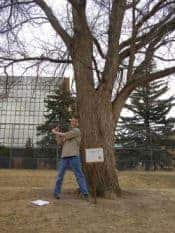Published by The City of Colorado Springs | Thursday November 29, 2012 | Written by Carrie McCausland
Although this article was written in November, All Seasons believes this is an important subject to think about all winter long!
- Wrap the trunk. In Colorado, thin-barked trees like honeylocust, ash, maple and linden are susceptible to sunscald and frost cracks because of the drastic temperature fluctuations in fall and winter. To prevent bark damage, guard the trunks of younger trees up to the first branches using commercial tree wrap. Leave the wrap on until April.
- Mulch the base. Apply 2 to 4 inches of wood chips, bark or other organic mulch near the base of the tree, but not against it, to reduce soil evaporation, improve water absorption and insulate against temperature extremes. Residents can pick up wood chip mulch free of charge across from the Parks and Recreation forestry building at 1601 Recreation Way.
- Recycle leaves. Instead of disposing of fallen leaves, consider layering them around the base of each tree as a natural mulch, or blend them into the yard with a mulching mower to retain nutrients. Note that residents are reminded to not rake or blow leaves and other yard debris into the street or storm drains. Doing so is a violation of City Code and can result in fines.
- Prune conservatively. Late winter is the best time for pruning most tree species, but it can be done whenever trees are dormant over the winter months. Common reasons for pruning are to remove dead branches and improve form. Always prune at the branch collar – the point where a branch joins a larger one – and don’t remove any branches without good reason.
- Give them a good drink. Slowly water each tree in the area from just outside the trunk to the extent of the longest branches. Water at the rate of 10 gallons per inch of tree diameter. To get the diameter measure the circumference of the tree's trunk (in inches) four feet up from the base of the tree and then divide by 3.















